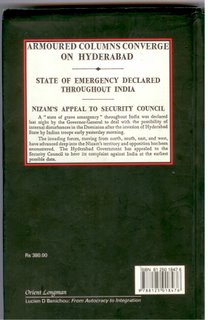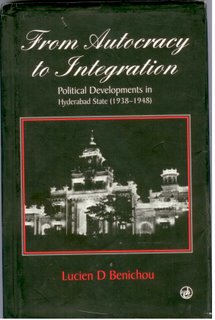However there is a strong school of thought - represented by the Hyderabad Historical Society - that in trifurcating the erstwhile Hyderabad State on linguistic lines was not one of the smartest things to do and most of the problems pertaining to communal harmony, and the question of underdevelopment of Telangana [and Marathwada region in Maharashtra and Hyderabad-Karnataka region in Karnataka] was a function of the break up of the erstwhile Hyderabad State. One significant book on this subject is Omar Khalidi's Hyderabad:After the Fall.
When I picked up the book "From Autocracy to Integration"

 by Lucien D Benichou I did that with a fair amount of expectation as it was supposed to have focussed on the political developments of the decade 1938-48 a period when most of the action happened in the run up to the integration of the Hyderabad state into the Indian Union and later its trifurcation on linguistic lines. While Hyderabad integrated itself with India, the state disintegrated!! The blurb was quite a teaser which said: "The book centres around the question of the nature and popularity of the annexation of Hyderabad. It also explores the question of whether this was the only way in which the transition to popular rule could have taken place. ..."
by Lucien D Benichou I did that with a fair amount of expectation as it was supposed to have focussed on the political developments of the decade 1938-48 a period when most of the action happened in the run up to the integration of the Hyderabad state into the Indian Union and later its trifurcation on linguistic lines. While Hyderabad integrated itself with India, the state disintegrated!! The blurb was quite a teaser which said: "The book centres around the question of the nature and popularity of the annexation of Hyderabad. It also explores the question of whether this was the only way in which the transition to popular rule could have taken place. ..."While the author seems to be asking the right type of questions, he does not make a very forceful arguement on the alternatives that could have been possible.
While there was much action in the decade that led up to the declaration of Independence of India, Hyderabad state was not fully integrated with the freedom movement led by the congress. The citizens of Hyderabad were badly divided and congress was not a big force to reckon with. The most significant congress leader of that time was Swami Ramananda Tirtha. There was little satyagraha and civil disobdience seen in this region.
The reasons could have been complex: The region was still ruled by the Nizam. While muslims were a minority in the state, the elite amongst them occupied positions of power in the government. The language of the court was Persian, and there was a widespread use of Urdu. In addition to the elite that were attached to the royal family [including the Paigahs] a large number of hindu zamindars owed their allegiance to the Nizam. While it is not clear whether they were in general happy with the rule of the Nizam, what is clear is that they had fair amount of powers and privileges which they would lose if autocracy was replaced with democracy. In addition to these two forces of the muslim nobility and the hindu elite, we also had nationalists like Swami Ramananda Tirtha trying to mobilise people for the freedom struggle. And this freedom was not only being sought from the British, but also from the Nizam. There were two other groups that were very active at that time - the communists [largely hindu by religion, though there were people like Makdoom Moinuddin with them] who were seeking liberation from the so called tyrannical rule of the Nizam and through him the zamindars - and were also opposed to the non-violent passive methods of the congress. There were Razakars, a small group of primitively armed volunteers who had largely aligned with the Nizam. However their basic alliegance was to the Majlis-e-Ittehad-ul-Muslimeen a militant group that played on the islamic identity of the people.
While Benichou's book does a good job of getting archival research and putting it together, I was somewhat disappointed with the quality of analysis. The book drifts with a series of incidents that happen in quick succession and Benichou does just the job of a dispassionate chronicler. It is not clear if there was a popular support to have Hyderabad as a single province - which is what the blurb hinted at. It is however clear that the major nationalist party was confused as far as mobilising people was concerned. The congress was fighting the British and the visible face of rule here was the Nizam. Therefore most of the methods and aims of the struggle were irrelevant in the context of Hyderabad. However, there were issues. The congress was largely represented by Hindus with clear linguistic identities of the three regions. It appears that the younger elements were not happy with the moderates - thus sections of congress breaking into Andhra Mahasabha and Maharashtra Parishad. Even the Andhra Mahasabha broke up with people like Ravi Narayana Reddy moving towards the communists.
On the other hand, the Maharashtra Parishad was also having its own divisions. For instance it is said that on the one hand sections of the congress were demanding that the Marathwada province of the Nizam's dominions be merged with United Maharashtra on achieving independence, there were dissentions within the Dominion itself with people like K S Vaidya and Narasing Rao [known to be congress moderates] indicating that the territorial integrity of the Hyderabad State had to continue even after independence. So it is not clear as to whether there was a unified will of the people aspiring for a Hyderabad State [with or without the Nizam].
In fact Benichou says something to this effect as we proceed with the book:"[In the context of the Cripps proposal] the future of the State took precedence over the [II World] War issue, and revived all the communial and political divisions. In the main, moderate Hindus remained silent, but the extremists asserted that Hyderabad should be absorbed into 'greater and democratic India' while Ittihad Muslims demanded the retention of the State as a separate 'independent entity"
Even after independence, before the police action one sees confusion. It also appears that while the communists in Telangana were being supported indirectly by the Congress, though they did not have a common cause with the congress. Benichou says: "it seems illogical that the Government of Madras should have given aid to the Communists who were the avoved enemies of the INC and that the Government of India should have turned a blind eye to this 'anomaly'. The compelling explanation, however, is that it was known in Delhi that the Hyderabad Congress by itself was divided and weak... and the communist activity in Telengana was therefore the only alternative means left to weaken the Nizam's regime.."
While the book generally postulates various possibilities as an alternative to the hurried "Police Action" and the high handed annexation of Hyderabad to the Indian Union, Benichou does not base his arguments on whether these were plausible at all, whether there was some strong undercurrent of a unified view on how the integration had to take place. The argument of Benichou is that if it was left alone like Goa, it would have eventually got integrated with the Union, because there would have been little choice. Hyderabad could not annexe with Pakistan due to its geography, and the same geography would come to the aid of ultimate integration with the Union because it would not only be landlocked, but surrounded by the Indian Union from all sides.
Benichou however, hints that the Nizam possibly failed in keeping his subjects with him in the later stages. He was seen as getting more and more influenced by Majlis [a fringe element at that time], was secluded and did not have much contact with the people. Osman Ali Khan was in a way a contrast to his predecessor Mehboob Ali Khan who was called the "beloved" of the people and enjoyed good rapport with with all sections of the society. While literature indicates that the moderates in both Hindu and Muslim communities articulated the mulki feeling "Hyderabad for Hyderabadis regardless of communities", unfortunately this got the most vociferous articulation from the Majlis and the Razakars. Possibly that was the political undoing of the unified Hyderabad state within the Indian union.
The trifurcation of the state was lamented by several people. Most of the icons of unified Hyderabad state got marginalised due to this and all the regions of the erstwhile Hyderabad became peripheral regions in the respective states they were integrated into. The roots of the Telangana movement can be traced possibly with the trifurcation. At least in Hyderabad, there was dominance of the people from coastal Andhra who could use the 'official language' Telugu much better and got into the administration in a big way. Mulkis on the other hand were formally trained in Urdu - this did become a handicap and also resulted in unemployment. In retrospect what was written in 1952 looks prophetic:
- Apart from suspensions, dismissals, retirements - forced and voluntary of the officers and men of almost all the Departments, there has been a attempt to retrench in the name of efficiency and because to aid the new personnel, instead of Urdu knowing staff, persons with knowledge of English and other regional languages were required.
- It is obvious that henceforth the doors of thes Departments [that were taken over by the Indian Union] would be closed up for the sons of the soil, who are already at a discount and opened wide...
- Another outstanding feature of the present change-over and integration ... would be instead of having its own income on the lines evolved hitherto, Hyderabad would have to depend on Subventions and doles from the Centre for carrying on, not only the day to day administration, but also for its nation-building activities.
The only disappointing point in this book is that it does not get any radically new material to the table, nor does it get any radically new interpretation of the archival material. However, it was indeed good to get back to this issue once again.



































































![Hyderabad: A Book [or two] and A Movie](https://blogger.googleusercontent.com/img/b/R29vZ2xl/AVvXsEjAmLvl2QbxUfgXz7zmpX8bbEXlCt6AkaenV_pM9yxdKEg4dFja9dFAcL040l_itCPD3fhOxRtVemx4FI8A0iOpP93Q2QGTIKrTu6LHlZ4znvSL6DVgf9_gZJjyTcIa6Y6kKFU9/s214/luther1.0.jpg)







![Two Lives [and this is not about Vikram Seth]](https://blogger.googleusercontent.com/img/b/R29vZ2xl/AVvXsEjyC1A9f3rufuLjzeVMA0crhn0qgiHBS1Zqt0ldHFt_WUOeymC3NpId-cTQmht91UoJzhPAZ78gRZyQe0N0dnnx_UY-0Rf-8FDFhycKolr1Aqao6gFhWGQx7mT0oAHCZ-K-4LPL/s214/mansur.jpg)





6 comments:
Hi, good effort to dig down into history..it would be great if you can get some historical background on why politicians raise sentiments on seperate Telangana.
Good post. I'd recommend V P Menon's Integration of Indian states for another perspective.
I believe Omar Khalidi has written on this subject too.
Interesting blog from a person in Ahmedabad, even more interesting comment from Ali. Growing up in Andhra we are mostly exposed to Congress/Indian version of the "Police Action". It is interesting to know the other point of view too.
This is the post that brought me to your great literary work. Yesterday, Omar Khalidi passed away, and I am surfing the Web to find those who know him and his work.
We can't reach his heights (as a scholar and as a professional), but we can at the least, follow his footsteps and spread the good word to others about his research methodology and contributions.
Here is the link to my post and a link to the FB:
http://lisindica.blogspot.com/2010/12/dr-omar-khalidi-rare-scholar-cum.html
Hello everyone, We're looking for kidney donors, Very urgently. B+ve , O+ve, O+ and A+ve with I'd Proof and age should be 19 and above. Interested persons should contact below.
Dr. Amar Ahirwar
Organising committee chairman
davegrayhospital.weebly.com
Tel/Whatsaap: +91-80507-736-51
E-mail: davegrayhospitaldelhi@gmail.com
We are urgently in need of kidney donors in Kokilaben Hospital India for the sum of $500,000,00,( 3 CRORE INDIA RUPEES) All donors are to reply via Email only: hospitalcarecenter@gmail.com or Email: kokilabendhirubhaihospital@gmail.com
WhatsApp +91 7795833215
Post a Comment